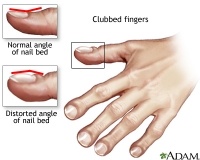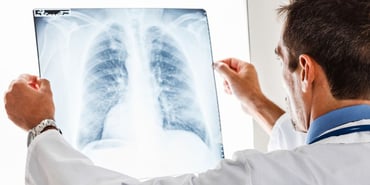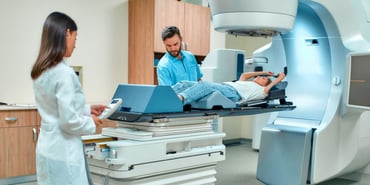
Lung cancer often doesn't show symptoms for a while. When they start to appear, the most common symptoms are lung-related and can include a persistent cough (especially if you're not congested), coughing up blood or excessive mucus, shortness of breath, and chest pain. However, you might be surprised to learn there are lung cancer symptoms that aren't related to your lungs. The presence of these symptoms does not mean you definitely have lung cancer, as they can be caused by other conditions as well. But it's important to see your doctor as soon as possible if you are experiencing these symptoms.
Seven symptoms of lung cancer that don’t have anything to do with the lungs:
- Finger clubbing.
- Weakness or numbness in the arm or shoulder.
- Unexplained loss of voice.
- Swelling and discoloration of upper body.
- Extreme thirst and frequent urination.
- The sudden desire to quit smoking.
- Horner syndrome
1. Clubbing of the Fingers and/or Toes

Clubbing, which is the enlargement of the fingertips or toes, happens when excess soft tissue forms beneath the nail beds. This buildup changes the way the nails grow from the nail bed. A normal finger or toe has a slight "V"-shaped angle between the nail and the nail bed. However, this angle is not there in a clubbed finger or toe due to the accumulated tissue.
Clubbing can be a sign of various conditions related to chronically low oxygen levels, including lung cancer. Doctors will discuss your smoking history and look for signs of nicotine stains on the fingers so they can determine which tests may be the best next step.
Finger clubbing in early lung cancer stages usually looks like a soft nail bed with shiny skin next to it. The nails may also appear more curved when viewed from the side, and the tips of the fingers may be larger than usual. In advanced lung cancer stages, clubbing may lead to the formation of extra bone along the joints of the fingers and wrists.
2. Arm and Shoulder Pain, Weakness, and/or Numbness
Lung cancer can spread from within the lungs to other areas of the body, pressing against nerves and causing pain to run from the shoulders and down the arms. This is especially important to note if you have this type of pain combined with other lung cancer symptoms such as coughing, chest pain, or unexplained weight loss.
There is also the possibility that the shoulder pain is caused by a rare type of lung cancer called Pancoast. These tumors spread from the top of the lung and develop along the nerves of the arms and shoulders. Pancoast tumors are usually accompanied by other symptoms. Doctors refer to this as Pancoast Syndrome.
Symptoms of Pancoast Syndrome can include:
- Shoulder pain that radiates to the inner part of the scapula (the large, flat bone that covers the ribs on the back)
- Pain that may extend to the inner arm, elbow, pinky, and ring fingers
- Swelling in the upper arm
- Tightness in chest
- Fatigue
- Unexplained weight loss
- Weakness, muscle loss, or lack of coordination in the hands
- Tingling or numbness in the hands
3. Loss of Voice or Hoarse Voice
Difficulty producing sounds or experiencing abnormal changes in speech can be an early symptom of lung cancer.
In advanced cases, loss of voice or hoarseness is common and can be caused by several factors, such as damage to the voice box from tumors pressing on the area between the lungs. Chronic coughing associated with lung cancer can also contribute to voice changes.
While laryngitis is a common cause of voice loss, you should consult your primary care doctor if you experience hoarseness or loss of voice for more than two weeks to rule out lung cancer as the cause.
4. Upper Body Swelling and Discoloration
As lung cancer spreads, it may produce tumors that restrict the large vein carrying blood away from the head and arms back to the heart. Such restrictions can slow blood flow and cause it to back up in the veins, leading to swelling in the face, neck, upper chest, and arms. The skin in these areas may take on a bluish-red hue.
Swelling can develop quickly or gradually. An early symptom may be facial or eye swelling upon waking in the morning. If you experience persistent swelling that does not resolve on its own, you should see a doctor.
5. Extreme Thirst and Frequent Urination
While increased thirst can occur with warmer weather, sudden extreme thirst is a symptom that should always be discussed with your doctor. Some lung cancer tumors can produce a protein similar to parathyroid hormone, which regulates calcium levels in the body.
Cancer tumors can interrupt this regulation, resulting in extra calcium in the bloodstream, a condition known as hypercalcemia. Up to 30% of people with cancer develop hypercalcemia, which is associated with increased thirst and frequent urination.
6. Sudden Desire and Ability to Quit Smoking
One of the most ironic warning signs of lung cancer is the sudden ability to quit smoking. While many smokers struggle to give up the habit, some manage to quit easily before receiving a lung cancer diagnosis.
Many patients quit smoking in hopes of alleviating symptoms like coughing or shortness of breath. Interestingly, these patients often find that, suddenly, quitting becomes easy. This behavior change may be related to changes in the body related to cancer.
Related Read: 6 Helpful Tips for Tobacco Users to Quit Smoking
A study published in the Journal of the International Association for the Study of Lung Cancer concluded that 48% of the 115 lung cancer patients they evaluated quit smoking spontaneously and with very little effort before a cancer diagnosis. Researchers believe that early lung cancer tumors may secrete substances that interfere with nicotine addiction.
7. Horner Syndrome
Horner Syndrome, which Pancoast tumors can also cause, arises when tumors affect the nerves leading to the eye or face.
Signs of Horner syndrome can cause:
- Drooping of the eyelid
- A small pupil
- Reduced sweating on the affected side of the face
Horner Syndrome is typically associated with advanced cases of lung cancer, occurring after cancer has spread to nerves in the neck. Once cancer reaches these nerves, one possible side effect is facial paralysis.
Be Watchful for Earlier Lung Cancer Detection
Both smokers and non-smokers are at risk of developing lung cancer. Regardless of your smoking history, it’s important to educate yourself on the common and uncommon signs and symptoms of lung cancer. If you notice any of these less common symptoms, especially in combination with lung-related lung cancer symptoms, you should talk with your doctor right away.
The earlier lung cancer is detected and diagnosed, the sooner cancer treatment can begin. Know the symptoms to watch for, and discuss scheduling a lung cancer screening with your doctor if you have a history of smoking. And most importantly, listen to your body and trust your instincts. Remember, it's never too late to quit smoking or change your habits to reduce your risk of developing lung cancer!
If you are diagnosed with lung cancer, whether it's your first diagnosis or the cancer has recurred, our lung cancer specialists in the Portland-Vancouver area are available to review your test results and discuss a treatment plan. Our team is here to help guide you.
Originally published April 2017. Updated December 2024.




